Now that the vineyard is planted, you need to know how to care for it properly. Read on to learn how to train and prune vines for optimum production and care.
Pruning
Prune vines in winter when dormant, between December and March. Pruning sets bud numbers and crop for harvest. It is important to learn proper pruning. A vine that is too large is prone to disease and has lower-quality fruit, and a small vine will not be productive.
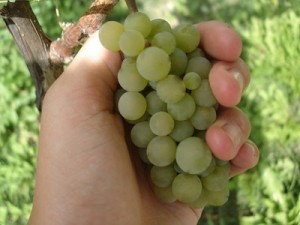 Grapes can be trained to conform to many shapes. The only limit is your imagination. Many backyard gardeners choose to use less traditional systems to train vines, so only a few basic pruning and training rules are needed. The structure the vines are trained to should be reasonably filled but not overgrown. This is much easier said than done, as vines initially grow slowly, but can become jungle-like when they mature. The best vegetation level for flower-bud and fruit development is to have one to two layers of leaves on the canopy.
Grapes can be trained to conform to many shapes. The only limit is your imagination. Many backyard gardeners choose to use less traditional systems to train vines, so only a few basic pruning and training rules are needed. The structure the vines are trained to should be reasonably filled but not overgrown. This is much easier said than done, as vines initially grow slowly, but can become jungle-like when they mature. The best vegetation level for flower-bud and fruit development is to have one to two layers of leaves on the canopy.- By their nature mature vines produce more wood than they can support. You will typically remove 90% of the new growth on mature grapevines during the winter. Leave three to four buds per foot of horizontal trunk on the vine.
- Grapes only bear fruit on the new canes.
- Growth will vary by cultivar. American canes tend to grow in a willowy, downward direction. Their European cousins and many French-American hybrids grow straight up. So choose your training method by how your cultivar grows.
Training Methods
When deciding how to train grapevines consider these three things:
- Getting the most full sunshine on the vines.
- Providing the best airflow in the vineyard.
- Allowing enough room for harvesting and maintenance.
Grapes do best on a gentle slope with an east-to-south exposure. After planting cut away the last season’s wood, leaving one cane for the trunk. Before training decide if you will have one wire or two wires for the vines. Once this decision is made, training is the same for the next three growing seasons, except that half way up you will train some of the canes/cordons, and the other half will be above them. Typically the first wire is at thirty-six inches above ground level, and the second wire is thirty-six inches above that.
- First Year – This is the year of planting. Once planted, cut back the wood to the two best buds to form your trunk. If shoots grow well, train the strongest up along a hemp string to the wire of the trellis support to develop the trunk. Trim back any remaining shoots to let your trunk develop well.
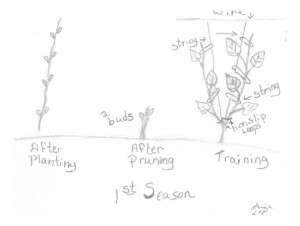
- Second Year – When vines are dormant, cut back the sprouts except the strongest bud near the top of the trunk – six to nine inches from the wire. These will be the cordon branches, or short arms, for cane growth. If too short, use some hemp string and tie to the trellis wire. Use hemp string along the branch every six to nine inches for added support. Remove any new shoots that develop below the level of the wire while they are small. Pinch them off at the branch. Pruning in summer months – July or later – will delay the maturity of the vines and stunt their growth.
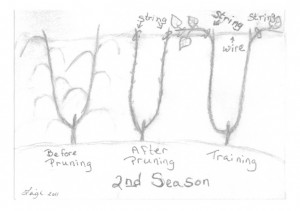
If cane growth is less than thirty-six inches long and/or less than ¼ inch in diameter, cut back all growth to two buds near the base of the best cane and train as stated above.
The Kniffin (Double Wire) system – This system trains one new, strong shoot vertically to the upper wire, then laterals are selected to train each way on both wires after the shoot has been tipped six inches below the top wire. Use hemp string for training, tying it to either a stake at the base of the vine or to the vine with a non-slip loop to avoid girdling. The tendrils around the trunk, arms, or canes that are to become permanent parts of the vine should be removed, thus preventing girdling.

Single-Curtain or Hudson River system – This cascading system is traditional for native or French-American hybrids. The wire used should be galvanized crinkle wire or bright basic number eight wire that has low stretchability, because once the system is established, there is no way to tighten the wire.
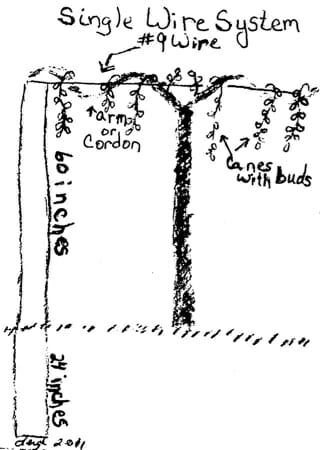
- Third Year – Train the canes laterally in each direction using either the single or double-wire system. Place canes trained as cordons bilaterally on single wire system over the west (or south) side of the wire and wrap around at least one full turn. Tie to wire with loose ties using hemp string to secure canes to wire at the point of first contact, at the mid-point along the wire and more tightly just behind the last bud. Double curtain systems will be tied to the wire in the same manner. If canes have not grown to this stage in their development, follow the procedure for younger vines above.
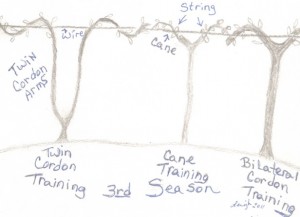
Cordons shouldn’t overlap. There should be at least one foot between them.
Caution: grapes have a tendency to overfruit. To avoid this, do not keep more than twenty to thirty flower buds on the most vigorous vines. If vines over produce at this age, it can reduce production over the next two to three years.
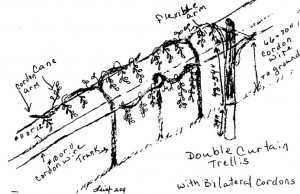
- Fourth Year (and following years) – If you desire cordon training, keep the canes that grew grapes in the third year for future cordons. Cut the growth on the cordon, leaving one bud and four bud canes alternately. Extending canes from the end of the cordon will fill in wires. Remove all other canes. If growing European cultivars, follow these directions alternating one and two bud canes once spur is pruned. Long cane training on a single wire keeps two of the two-bud renewals at the base adjacent to trunk and four of the six-to-eight-bud canes farther out for fruit production. Train, in opposite directions, two canes. If using the two-wire Kniffin system, choose canes in the same manner for both wires. Leave renewal buds for each level on the arm neat the trunk.
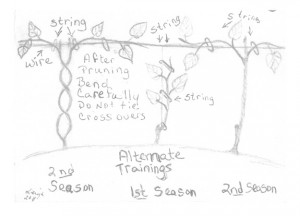
If you are interested in growing grapes in containers check out these sites:
https://www.container-gardening-tips.com/container-fruit-gardening/growing-grapes-in-containers.html
https://www.weekendgardener.net/growing-grapes/grow-grapevines-in-pots.htm
For more information on training grapes and there common pests check out these sites:
https://cru.cahe.wsu.edu/CEPublications/eb0637/eb0637.pdf
https://pubs.cas.psu.edu/FreePubs/pdfs/UL212.pdf
©2011 Off the Grid News
—————————————————————————-
Miracle “Sea Nutrients” For Award Winning Size And Flavor!
Natural Fertilizer Doubles Garden Production!
 Off The Grid News Better Ideas For Off The Grid Living
Off The Grid News Better Ideas For Off The Grid Living

 Grapes can be trained to conform to many shapes. The only limit is your imagination. Many backyard gardeners choose to use less traditional systems to train vines, so only a few basic pruning and training rules are needed. The structure the vines are trained to should be reasonably filled but not overgrown. This is much easier said than done, as vines initially grow slowly, but can become jungle-like when they mature. The best vegetation level for flower-bud and fruit development is to have one to two layers of leaves on the canopy.
Grapes can be trained to conform to many shapes. The only limit is your imagination. Many backyard gardeners choose to use less traditional systems to train vines, so only a few basic pruning and training rules are needed. The structure the vines are trained to should be reasonably filled but not overgrown. This is much easier said than done, as vines initially grow slowly, but can become jungle-like when they mature. The best vegetation level for flower-bud and fruit development is to have one to two layers of leaves on the canopy.

